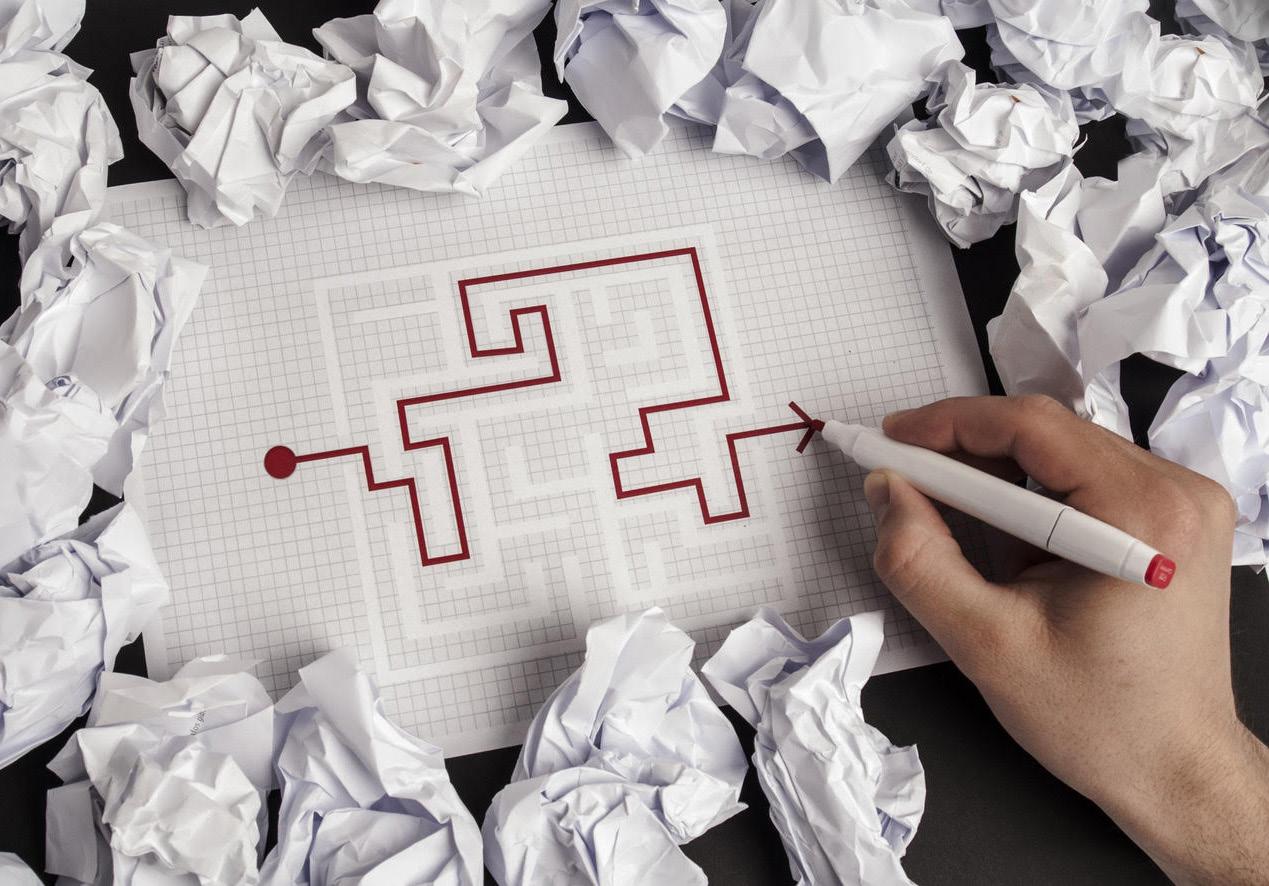
7 minute read
The Bad, The Old, and the Ugly
The Bad, The Old & the Ugly
by Martin Velasco
Advertisement
As someone who has struggled with depression and symptoms of ADD, I understand how difficult it can be just to get out of bed, let alone find help. And it’s not like I don’t want the help. Like most of you, I just want to live a normal life. I want an education. I want to work and provide for my family. I want to pick up those hobbies I used to love and call back my friends. But most of all, I want my life back. I want to wake up and feel like I have a future. I want to walk outside and enjoy the blue sky again. And when someone asks, “How are you?” I want to smile and say I’m good—and truly mean it. But the reality is that we are in the middle of a mental health crisis. There are roughly 43 million people in the U.S. suffering from mental illness—that’s more than the population of California. And those are just the people that are open about it. God only knows how many more are suffering in silence. Yet, the system put in place to help meet the growing need is ridiculously expensive, old, and just plain broken.
The Price is Just Too High
I don’t have to tell you that medical care is expensive. But medical care for mental illness is notoriously pricey. For those that are lucky, a local college counselor or a close friend and some lifestyle changes are enough to keep their demons at bay. But others aren’t so lucky. For those with severe mental illness, it is imperative not only that they seek counseling, but that they also find a good psychiatrist to diagnose and prescribe them with proper medication. Neither of these options is cheap. Although insurance may partially cover the cost of your medication, it’s unlikely that a psychiatrist will take it. Most psychiatrists run a cash only business. To give you an idea of what it can cost, a popular psychiatrist in our area will charge $500 just for a consultation. After that, it’s $100 for every 15-minute session. It’s no wonder we choose to selfmedicate, or it takes us an average of 10 years to get proper treatment after symptoms of depression have emerged. We live in a society where we’re forced to choose between our mental health and paying our bills. Alexandra Farmisaran is a hardworking wife and artist out of Woodlake and an old friend of mine. She has been struggling with depression since childhood, with her first suicidal thoughts appearing as early as the fifth grade. This followed her into adulthood and lead to multiple hospitalizations. “I would have owed tens of thousands of dollars to the hospital if I didn’t have insurance,” Farmisaran said. “I just think it’s funny how if you’re dealing with depression and not wanting to live and then get hit with these hospital bills, it would make me want to kill myself even more to escape that because I’d never be able to pay it off while dealing with all my other debts.”
A Dying Profession
Psychiatry is one of the oldest workforces in the United States. According to the Permanent Journal and notable physician firms like Merrit Hawkins, most psychiatrists have met or are near retirement age. In fact, nearly half of them are expected to retire within the next five years. So while the demand for mental health services is growing, the supply of psychiatrists is dwindling. There are states like Idaho where there are only five psychiatrists for every 100,000 people. And the story repeats itself beyond the psychiatry field. Other departments in the mental health arena routinely find themselves understaffed and overwhelmed with patients. It’s not uncommon for people to find themselves on a waiting list for weeks or even months before they can see a counselor. And once you do get a counselor, there’s no guarantee that they’ll be a good match or that they’ll stick around. I have, personally, gone through a variety of therapists before finally finding my current one. That was after dealing with a revolving door of “student therapists,” just completing their hours, because I couldn’t afford or find a psychotherapist with more experience.
And while counseling is helpful, these are professionals that lack the ability to diagnose and prescribe needed medication. And as we know, mental health treatment is a multifaceted approach. More often than not, just talking about your problems simply isn’t enough. So even after years of searching and finally finding a good therapist with experience, I was still stuck with an incomplete treatment plan that significantly delayed my healing process.
Forget the System
Call me a hippie revolutionist, but there’s no denying the system is broken. The traditional approach to treating mental illness has its merits, but it’s vastly outweighed by the downfalls. Prices are high, waitlists are long, medications can have an assortment of terrible side effects, and the system, as it stands now, only seems to be serving our most wealthy and privileged. The U.S. National Library of Medicine | National Institutes of Health revealed that “Elderly, minorities, and low-income groups, uninsured, and residents of rural areas are less likely to receive adequate mental health care, and most people with severe mental health problems receive no treatment or inadequate treatment for their disorders.” In other words, it’s the people that need help the most who are being left in the dark. Not to mention the stigma surrounding mental illness. Part of the reason why treatment is so expensive is because of the way our society views mental illness. Insurance companies simply don’t see mental illness as a legitimate medical issue, like they would if someone was diagnosed with cancer or heart disease, despite mental illness being the leading cause of disability in the world! It’s time for a new approach.

Team Work, Openness, and Advocacy
The good news—and yes, there is good news—is that medical professionals are not blind to the ugliness of the mental health system. They agree that the conventional approach to mental illness is not working, and they’ve already taken the initiative to change things up. The first step is to take on a more collaborative approach to treating mental illness. Psychotherapist, psychiatrists, primary doctors, and nurses need to work together in the same clinical setting. There are some smaller medical institutions that have implemented this approach with positive results. Numerous studies have found that institutions that incorporate the collaborative care model have reduced the price of treatment for all socioeconomic groups and are more effective at treating mental illness.
The second piece of the puzzle is rethinking what we define as treatment. Healing can blossom out of a good therapist and a proper prescription. But that doesn’t mean it’s the only way. More and more medical professionals are suggesting that patients try alternative medical treatments to supplement their regular treatment. Acupuncture has been found useful to treat anxiety. Mindfulness exercises through meditation are useful to treat symptoms of schizophrenia and other mood disorders. And herbal supplements like omega-3 fatty acids and holy basil are often recommended. We get so caught up in our western drug-based medicine culture that we forget there are other schools of thought, like Chinese and Ayurvedic medicines that yield positive results. All of this coupled with a shift in philosophical thinking and healthy lifestyle changes can help fill the gap where the system can’t and lead to great improvement of our physical and mental health.
The final step is the most important. We need to shift the status quo. We need to speak up, advocate, and strive to stop the stigma that surrounds mental illness. That means being vulnerable and opening up and sharing our own struggles. It means taking action. It means that when a friend or family member says they are struggling, you don’t just listen; you pick up the phone and make that call with them. It means taking their hand and walking alongside them to the Clubhouse or to that next appointment when you can. Yes, we are in the middle of a crisis with an old, understaffed, and overpriced system. But we have more tools and support than we think. Breathe Magazine and Clubhouse Visalia are just the beginning, a new beginning. And we all have a long journey ahead of us. But we don’t have to walk it alone. Not anymore.
Martin Velasco-Ramos
is a journalist for the Valley Voice newspaper double majoring in English and Psychology at College of the Sequoias.











